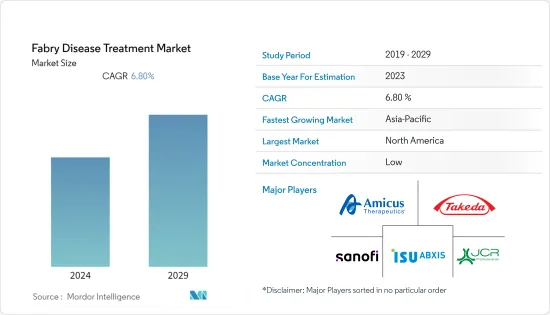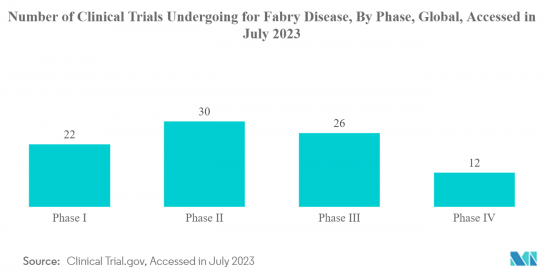
패브리병 치료 시장은 예측 기간 동안 CAGR 6.8%를 기록할 전망입니다.

COVID-19는 패브리병 치료제 시장에 큰 영향을 미쳤습니다. 병원에서 치료를 받고 있던 패브리병 환자는 유행 초기에 의료 스태프에 의한 약제 주입의 지연이나 약제 주입 서비스의 중단을 경험했기 때문입니다. 또한 COVID-19에 감염된 패브리병 환자는 면역계 기능의 변화를 목격했습니다. 예를 들어, 2022년 6월에 PubMed에 게재된 논문에 따르면, 패브리병(FD) 환자에서 COVID-19의 중증화 위험은 FD 자체보다는 면역계에 의해 야기되었습니다. 따라서 FD의 합병증은 COVID-19에 의해 악화되었습니다. 그러나 즉각적인 약물을 사용할 수 없습니다는 것은 시장 성장에 큰 영향을 미쳤습니다. 게다가 FD 치료의 진보 상승과 주요 시장 진출기업의 강력한 파이프라인 자산으로 시장은 향후 수년간 큰 성장을 보일 것으로 기대되고 있습니다.
시장 성장의 요인으로는 패브리병 치료와 관련된 인지도의 급상승, 패브리병과 관련된 연구개발 증가, 유망한 파이프라인 제품 등을 들 수 있으며 시장 성장을 견인하고 있습니다. 패브리병과 관련된 인지도는 환자와 의료진에게 매우 중요합니다. 최근 미국과 영국을 비롯한 다양한 국가에서 패브리병 치료에 대한 인식이 높아지고 있습니다. 예를 들어, 미국 패브리 병재단(NFDF)에 따르면, 미국은 매년 4월을 패브리 병 계발 월간으로 하고 있습니다. 계발 프로그램에는 일반 시민, 환자, 간병인 및 의료 전문가에 대한 교육이 포함됩니다. 게다가 이 계발활동은 패브리병에 대한 인식, 진단, 관리의 향상에 도움이 되며, 조사기간 동안 시장 성장을 가속할 것으로 기대되고 있습니다.
또한, 패브리병 치료와 관련된 연구개발 증가와 자금조달 증가도 시장 성장을 가속할 것으로 예상됩니다. 예를 들어, 2022년 12월, Bio Sidus SA는 이미 Fabrazyme으로 치료되었고 이전에 안정화된 FD 환자에서 AGA BETA BS의 효능과 안전성을 평가하는 임상시험을 후원했습니다. 또한 규제 당국의 승인을 받을 수 있는 다양한 패브리병 파이프라인 제품도 시장 성장을 가속하고 있습니다. 예를 들어, 2021년 8월, 유럽 위원회는 Amicus Therapeutics에서 판매하는 Galafold를 12세 이상의 패브리병 환자의 장기 치료제로 승인했습니다.
이와 같이 FD의 인지도 향상, 제품출시 증가, FD 치료에 대한 규제 당국의 승인에 의해 조사 대상 시장은 조사 기간 중에 대폭적인 성장이 예상됩니다. 그러나 신흥국의 진단 자원 부족은 조사 기간 동안 시장 성장을 방해하는 것으로 보입니다.
패브리병 환자는 만성 신장병과 심장 섬유증과 같은 장기 장애가 발생하기 전에 조기에 치료를 시작하면 효소 보충 요법에서 임상 혜택을 얻을 수 있습니다. 패브리병의 치료에 사용되는 두 가지 중요한 효소 보충 요법은 아가르시다아제 베타와 아가르시다아제 알파입니다. 또한, 이들 2개는 투여에 의해 α-갈락토시다아제 A의 작용을 모방합니다.
패브리병 치료에 있어서의 효소 보충 요법에 대한 수요 증가와, 환자에 있어서의 양호한 결과로부터, 연구 부문은 크게 성장할 것으로 예상됩니다. 이는 패브리자임과 같은 효소 보충 요법이 패브리병의 주요 원인에 작용하기 때문입니다. 예를 들어, 패브라이자임은 α-갈락토시다아제의 부족을 야기하는 GLA 유전자의 돌연변이를 다룬다. 2022년 10월에 'Frontier Journal'에 게재된 논문에 따르면, ERT는 파브리병의 치료에 성공하고, GLA 효소의 외인성 보충을 수반합니다. 또한, 효소 보충 요법(ERT)이 FD에 사용되면 수명이 연장 될 수 있음이 연구에 의해 입증되었습니다. 예를 들어, 2022년 5월 IntechOpen 저널에 게재된 논문에 따르면, 효소 보충 요법은 FD를 치유할 수 있으며, 환자에게 기존보다 훨씬 더 긴 수명과 심각한 전신 증상을 줍니다. 따라서 FD에서 효소 보충 요법의 채용이 증가하고 있기 때문에 ERT 수요가 증가하고 예측 기간 동안 부문 성장에 기여할 것으로 예상됩니다.
또한, 제약 회사는 패브리병을 치료하는 새로운 아가르시다아제 베타 약물의 판매 전략을 채택하고 있습니다. 예를 들어, JCR Pharmaceuticals는 2022년 3월, 패브리병 치료를 위한 아가르시다제 βBS 점적정주의 일본에서의 판매에 대해 Sumitomo Dainippon Pharma와 계약을 체결했습니다. 이러한 주요 기업의 전략적 합의는 ERT의 가용성을 높여 조사 기간 동안 시장 성장을 더욱 촉진할 것으로 예상됩니다.
따라서 FD에서 ERT가 제공하는 이점이 증가하고 주요 기업에 의한 다양한 전략적 합의로 조사 대상 부문은 조사 기간 동안 큰 시장 성장을 보일 것으로 예상됩니다.

북미는 높은 의료 지출, 패브리병과 관련된 인지도 상승, 이 지역의 주요 시장 진출기업의 파이프라인 자산과 제품출시 증가로 예측기간에 걸쳐 건전한 성장을 보일 것으로 예상됩니다. 예를 들어, Genzyme은 2022년 3월, 치료되지 않은 또는 6개월 이상 치료되지 않은 성인 패브리병 환자를 대상으로 패브리병의 신경 장애 증상과 복통 증상에 대한 벤글스탯의 효과를 평가하는 임상시험을 시작했습니다. 했습니다. 이러한 임상시험에서 좋은 결과가 얻어지면, 향후 신제품이 시장에 도입될 수 있고 시장 성장에 기여할 수 있습니다.
게다가 지역 전체에서 희귀질환에 자금을 제공하고 지원하는 정부의 이니셔티브는 조사 기간 동안 시장 성장을 뒷받침할 것으로 예상됩니다. 예를 들어, 2023년 3월 캐나다 보건부 장관은 3년간 최대 15억 달러를 투자하는 최초의 희귀질환 치료 약국 전략 중 하나를 지원하는 조치를 발표했습니다. 이를 통해 정부는 소아를 포함한 캐나다 전역의 환자의 건강을 개선하여 희귀질환에 대한 효과적인 의약품에 대한 접근성을 향상시키고 구매하기 쉽습니다.
그러므로 FD 요법과 관련된 파이프라인 연구 증가와 희귀질환을 지원하기 위한 정부의 고액 투자는 연구 시장이 예측 기간 동안 북미에서 큰 성장을 보일 것으로 기대됩니다.
패브리병 치료 시장은 세계 및 지역적으로 소수의 대기업이 활동하고 있기 때문에 그 성격상 통합되어 있습니다. 시장의 주요 기업으로는 Sanofi(Genzyme Corporation), Takeda Pharmaceutical Company Limited, Amicus Therapeutics, Inc, ISU ABXIS, JCR Pharmaceuticals, Protalix BioTherapeutics 등이 있습니다.

The Fabry disease treatment market is expected to register a CAGR of 6.8% over the forecast period.
COVID-19 significantly impacted the Fabry disease treatment market since Fabry disease patients receiving treatment in the hospitals experienced delayed drug infusion or disruptions in drug infusion services provided by the healthcare staff during the early pandemic period. Also, the COVID-19-infected Fabry disease patients witnessed changes in their immune system functions. For instance, according to the article published in June 2022 in PubMed, in Fabry Disease (FD) patients, the risk for severe COVID-19 was driven by the immune system rather than by FD itself. Thus, the complication of FD was exacerbated due to COVID-19; however, the unavailability of immediate medication significantly impacted the market growth. Besides, the market is expected to witness significant growth in the coming years owing to the rise in advancements in FD treatment and strong pipeline assets by the key market players.
The factor contributing to the market's growth includes a surge in awareness associated with Fabry disease treatment, a rise in R&D related to Fabry disease, and promising pipeline products, which drives the market's growth. Awareness associated with Fabry's disease is crucial for patients and healthcare staff. In recent years, there has been a rise in awareness related to treating Fabry disease in different countries such as the United States, United Kingdom, and others. For instance, according to the National Fabry Disease Foundation (NFDF), 'April' is observed as Fabry Disease Awareness Month annually in the United States. The awareness programs include educating the public, patients, caregivers, and healthcare professionals. Furthermore, the awareness activities help to enhance the perception, diagnosis, and management of Fabry disease, which is thereby expected to drive market growth over the study period.
In addition, the rise in research and development and increase in funding related to Fabry disease treatment is also expected to fuel the market growth. For instance, in December 2022, Bio Sidus SA sponsored a clinical trial to evaluate the efficacy and safety of AGA BETA BS in patients with FD already treated and previously stabilized with Fabrazyme. Also, various Fabry disease pipeline products that have the potential to receive regulatory approvals also drive the growth of the market. For instance, in August 2021, the European Commission approved Galafold, marketed by Amicus Therapeutics, for the long-term treatment of Fabry disease patients aged 12 years and above with an amenable mutation.
Thus, owing to the increased awareness of FD, the rise in product launches, and regulatory approval for FD therapies, the studied market is expected to witness significant growth over the study period. However, the lack of diagnostic resources in emerging countries will impede market growth over the study period.
Patients with Fabry disease may benefit clinically from enzyme replacement therapy when treatment is started early before the development of organ damage such as chronic kidney disease or cardiac fibrosis. The two significant enzyme replacement therapies employed in treating Fabry disease include Agalsidase Beta and Agalsidase Alfa. Furthermore, upon administration, both of these mimic the actions of alpha-galactosidase A.
The studied segment is expected to grow significantly due to the higher demand for enzyme replacement therapies in treating Fabry disease and their positive outcome in patients. This is because enzyme replacement therapies such as Fabrazyme work on the primary cause of Fabry disease. For instance, Fabrazyme addresses mutations in the GLA gene, which causes the lack of alpha-galactosidase. According to an article published in October 2022 in Frontier Journal, ERT was used successfully to treat Fabry disease and entails the exogenous replacement of the GLA enzyme. Furthermore, studies demonstrated the probability of a more extended life period when enzyme replacement therapies (ERTs) are employed for FD. For instance, as per the article published in May 2022 in IntechOpen journal, enzyme replacement therapy is possible to cure FD, giving patients substantially longer life expectancies and less severe systemic symptoms than in the past. Thus, owing to the increased adoption of enzyme replacement therapies in FD, the demand for ERT is likely to rise, contributing to segment growth over the forecast period.
In addition, pharmaceutical companies are adopting strategies to market new agalsidase beta drugs to treat Fabry disease. For instance, in March 2022, JCR Pharmaceuticals Co., Ltd. entered into an agreement with Sumitomo Dainippon Pharma Co., Ltd. for marketing Agalsidase Beta BS I.V. Infusion in Japan to treat Fabry disease. Thus, owing to such a strategic agreement by the key players, the availability of ERT is expected to rise, further boosting the market growth over the study period.
Hence, owing to the rise in advantages offered by the ERT in FD and various strategic agreements by the key players, the studied segment is expected to witness significant market growth over the study period.

North America is expected to witness healthy growth over the forecast period owing to the high healthcare expenditure, rise in awareness related to Fabry disease, and increase in pipeline assets and product launches of key market players in the region. For instance, in March 2022, Genzyme initiated a clinical trial to evaluate the effect of venglustat on neuropathic and abdominal pain symptoms of Fabry disease in adult participants with Fabry disease who are treatment-naive or untreated for at least 6 months. Such clinical trials may lead to positive results leading to the introduction of new products in the market in the future and hence may contribute to the growth of the market in the future.
Furthermore, government initiatives to fund and support rare diseases across the region are expected to bolster market growth over the study period. For instance, in March 2023, the Minister of Health Canada publicized measures to support one of the first National Strategies for Drugs for Rare Diseases, with an investment of up to USD 1.5 billion over three years. Through this, the government increases access to and affordability of effective drugs for rare diseases to improve the health of patients across Canada, including children.
Therefore, owing to the rise in pipeline studies related to FD therapies and high investment from the government to support rare diseases, the studied market is expected to witness significant growth in North America over the forecast period.
The Fabry disease treatment market is consolidated in nature due to the presence of a few major players operating globally and regionally. A few of the major companies in the market are Sanofi (Genzyme Corporation), Takeda Pharmaceutical Company Limited, Amicus Therapeutics, Inc, ISU ABXIS, JCR Pharmaceuticals Co., Ltd., Protalix BioTherapeutics, among others.